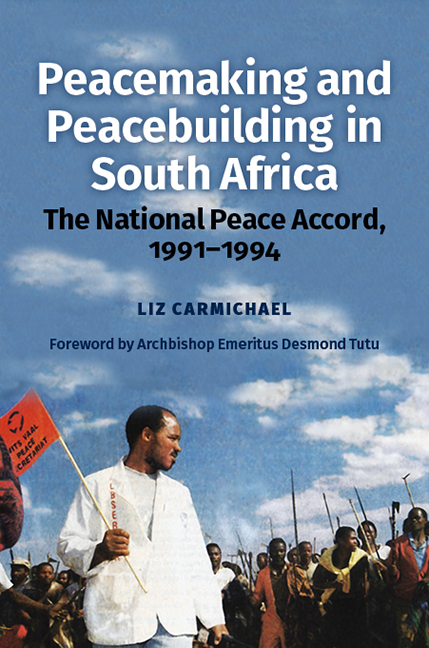Book contents
- Frontmatter
- Dedication
- Contents
- List of Illustrations
- List of Abbreviations
- Glossary
- Acknowledgements
- Note on Nomenclature
- Transition Timeline
- Foreword
- Introduction
- Part One Peacemaking, Peacebuilding, and the South African Conflict
- Part Two Peacemaking
- Part Three Peacebuilding
- Conclusion: Impact and Unfinished Business
- Bibliography
- Index
Introduction
Published online by Cambridge University Press: 08 October 2022
- Frontmatter
- Dedication
- Contents
- List of Illustrations
- List of Abbreviations
- Glossary
- Acknowledgements
- Note on Nomenclature
- Transition Timeline
- Foreword
- Introduction
- Part One Peacemaking, Peacebuilding, and the South African Conflict
- Part Two Peacemaking
- Part Three Peacebuilding
- Conclusion: Impact and Unfinished Business
- Bibliography
- Index
Summary
The National Peace Accord (NPA), South Africa's first consensus document, was signed in Johannesburg on 14 September 1991 at the National Peace Convention, the most comprehensive gathering of races, political leaders and organizations yet seen in the nation's history. This book provides the first full account of the Peace Accord. It tells how, through the peace structures under the Accord, thousands of ordinary people became involved in making and building peace as South Africa transitioned in a few short, breath-taking years from the deeply racist system of apartheid to become a free, multiracial democracy. It brings into view an aspect of that transition which has been obscure, yet was vital.
The Peace Accord, signed eighteen months after Mandela's release in February 1990, was another ‘watershed’ in South Africa's history. It opened the way for the commencement of constitutional talks at ‘Codesa’ in December 1991, and it set up structures to implement itself. Roelf Meyer, the National Party government's chief negotiator both for the Accord and the Interim Constitution, states simply: ‘I think it's fair to say that there would not have been a peaceful process of constitutional negotiations if we didn't have the National Peace Accord’. The two parallel exercises of negotiating an Interim Constitution on one hand, and grassroots peacebuilding on the other, led to the remarkably peaceful first democratic election in April 1994. The Interim Constitution enshrined the promise that there would be amnesty, and the final (and most widely remembered) transitional exercise was the Truth and Reconciliation Commission (TRC), which held its hearings from 1996 to 1998.
There is a tendency, in historical memory, to telescope this intense period: Mandela was released, then the election happened – and there was a TRC. But the work done in the years 1991–94 was key. ‘What we managed to pull off in those four years is astoundingly miraculous really’.
Many who experienced that period recall the Peace Song and the Peace Doves logo but were less aware, even then, of the peace committees. ‘Their role’, Judge Albie Sachs comments, ‘was so important, yet has dropped right out of sight’.
- Type
- Chapter
- Information
- Peacemaking and Peacebuilding in South AfricaThe National Peace Accord, 1991-1994, pp. 1 - 4Publisher: Boydell & BrewerPrint publication year: 2022



